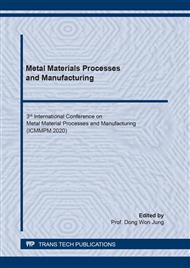[1]
Krutika Vishwakarma, Microstructural analysis of weld cracking IN718 plus superalloy, 2007, University of Manitoba, PhD dissertation.
Google Scholar
[2]
O.A. Odowu, O.A. Ojo, M.C. Chaturvedi, Crack-free electron beam welding of Allvac 718 plus superalloy, Welding Journal, Vol.88 (2009),179s-187s.
Google Scholar
[3]
Oyedele Temitope Ola, A study of laser-arc hybrid weldability of nickel-based Inconel 738LC superalloy, 2013, University of Manitoba, PhD dissertation.
Google Scholar
[4]
O.T. Ola, O.A. Ojo, M.C. Chaturvedi, Laser-arc hybrid weld microstructure in nickel-based IN738 superalloy. Materials Science and Technology, Vol.29(4)(2013),426-438.
DOI: 10.1179/1743284712y.0000000129
Google Scholar
[5]
O.T. Ola, O.A. Ojo, M.C. Chaturvedi, Role of filler alloy composition on laser-arc hybrid weldability of nickel-based IN738 superalloy. Materials Science and Technology, Vol.30(2)(2014), 1461-1469.
DOI: 10.1179/1743284713y.0000000436
Google Scholar
[6]
Lawrence Opeyemi Osoba, A study of laser weldability improvement of newly developed Haynes 282 superalloy, 2012, University of Manitoba, PhD dissertation.
Google Scholar
[7]
Wei Chen, Composition effects on macroscopic solidification segregation of superalloys, 2000, West Virginia University, PhD dissertation.
Google Scholar
[8]
Adam Ghoneim, Numerical simulation and experimental study of transient liquid phase bounding of single crystal superalloys, 2011, University of Manitoba, PhD dissertation.
Google Scholar
[9]
Olanerw Akanbi Ojo, On liquation cracking of cast Inconel 738LC superalloy welds, 2004, University of Manitoba, PhD dissertation.
Google Scholar
[10]
O.A. Ojo, N.L. Richards, M.C. Chaturvedi, Microstructural study of weld fusion zone of TIG welded IN738LC nickel-based superalloy, Scripta Materialia, 51(2004),683-688.
DOI: 10.1016/j.scriptamat.2004.06.013
Google Scholar
[11]
O.A. Ojo, N.L. Richards, M.C. Chaturvedi, Study of the fusion zone and heat-affected zone microstructures in tungsten inert gas-welded Inconel738LC superalloy, Metallurgical and Materials Transactions A, Vol.37A(2006),421-433.
DOI: 10.1007/s11661-006-0013-2
Google Scholar
[12]
M.Montazeri, F. Malek Ghaini, O.A. Ojo, Heat input and liquation cracking of laser welded IN 738LC superalloy, Welding Journal, Vol.92(2013),258s-264s.
Google Scholar
[13]
Jonathan Durocher, Thermo-mechanical fatigue of polycrystalline directionally solidified and single crystal nickel-based superalloys repaired by laser beam welding, 2013, University of Manitoba, PhD dissertation.
Google Scholar
[14]
J.Durocher, N.L. Richards, Evaluation of the low heat input process for weld repair of nickel- based superalloys. Journal of Materials Engineering and Performance, Vol.20 (7) (2011), 1294-1303.
DOI: 10.1007/s11665-010-9749-3
Google Scholar
[15]
A.T. Egbewande, R.A. Buckson, O.A. Ojo, Analysis of laser beam weldability of Inconel 738 superalloy, Materials Characterization, 61(2010),569-574.
DOI: 10.1016/j.matchar.2010.02.016
Google Scholar
[16]
A.T. Egbewande, H.R. Zhang, R.K. Sidhu, O.A. Ojo, Improvement in laser weldability of Inconel 738 superalloy through microstructural modification, Metallurgical and Materials Transactions A, Vol.40A(2009), 2694-2704.
DOI: 10.1007/s11661-009-9962-6
Google Scholar
[17]
R.K. Sidhu, O.A. Ojo, M.C. Chaturvedi, Microstructural analysis of laser-beam welded directionally solidified Inconel 738, Metallurgical and Materials Transactions A, Vol.38A(2007), 858-870.
DOI: 10.1007/s11661-006-9063-8
Google Scholar
[18]
N.L. Richards, M.C. Chaturvedi, Effect of minor elements on weldability of nickel-based superalloys. International Materials Revirews, Vol.45(3)(2000),109-129.
DOI: 10.1179/095066000101528331
Google Scholar
[19]
Y.L. Wang, O.A. Ojo, R.G. Ding, M.C. Chaturvedi, Weld metal cracking in laser beam welded single crystal nickel-based superalloys. Materials Science and Technology, 2009, Vol.25 (1), 68-75.
DOI: 10.1179/174328407x185938
Google Scholar
[20]
R.G. Ding, O.A. Ojo, M.C. Chaturvedi, Fusion zone microstructure of laser beam welded directionally solidified Ni3Al-based alloy IC6, Scripta Materialia, 54(2006), 859-864.
DOI: 10.1016/j.scriptamat.2005.11.010
Google Scholar
[21]
T.D. Anderson, J.N. Dupont, T.Debroy, Origin of stray grain formation in single-crystal superalloy weld pools from heat transfer and fluid flow modeling, Acta Materialia, 58(2010), 1441- 1454.
DOI: 10.1016/j.actamat.2009.10.051
Google Scholar
[22]
M.Rappaz, S.A. David, J.M. Vitek, L.A. Boatner, Analysis of solidification microstructures in Fe-Ni-Cr single-crystal welds, Metallurgical Transactions A, Vol.21A(1990),1767-1782.
DOI: 10.1007/bf02672593
Google Scholar
[23]
M.Rappaz, S.A. David, J.M. Vitek, L.A. Boatner, Development of microstructures in Fe-15Ni-15Cr single crystal electron beam welds, Metallurgical Transactions A, Vol. 20A(1989), 1125-1138.
DOI: 10.1007/bf02650147
Google Scholar
[24]
J.M. Vitek, The effect of welding conditions on stray grain formation in single crystal welds- theoretical analysis, Acta Materialia,53(2005),53-67.
DOI: 10.1016/j.actamat.2004.08.039
Google Scholar
[25]
Edward H. Kottcamp. ASM Handbook, Volume 3, Alloy phase diagrams, ASM International, USA,1993,49-155.
Google Scholar
[26]
Wu Qiong, Li Shusuo, Ma Yue, Gong Shengkai, First principles calculations of alloying element diffusion coefficient in Ni using the five-frequency model, Chin.Phys.B, Vol.21(10)(2012), 1091021-1-7.
DOI: 10.1088/1674-1056/21/10/109102
Google Scholar
[27]
Weiping Liu, J.N. Dupont, Effects of melt-pool geometry on crystal growth and microstructure development in laser surface-melted superalloy single crystals. Mathematical modeling of single- crystal growth in a melt pool (Part I), Acta Materialia,52(2004),4833-4847.
DOI: 10.1016/s1359-6454(04)00390-8
Google Scholar
[28]
Weiping Liu, J.N. Dupont, Effects of substrate crystallographic orientations on crystal growth and microstructure development in laser surface-melted superalloy single crystals. Mathematical modeling of single-crystal growth in a melt pool (Part II), Acta Materialia,53(2005),1545-1558.
DOI: 10.1016/j.actamat.2004.12.007
Google Scholar
[29]
J.W. Park, S.S. Babu, J.M. Vitek, E.A. Kenik, S.A. David, Stray grain formation in single crystal Ni-based superalloy welds, Journal of Applied Physics, Vol.94(6)(2003),4203-4209.
DOI: 10.1063/1.1602950
Google Scholar
[30]
J.M. Vitek, S.S. Babu, J.W. Park, S.A. David, Analysis of stray grain formation in single-crystal nickel-based superalloy welds, Proceedings of International Symposium on Superalloys, 2004, 459- 465.
DOI: 10.7449/2004/superalloys_2004_459_465
Google Scholar
[31]
J.M. Vitek, S.A. David, S.S. Babu, Optimization of weld conditions and alloy composition for welding single-crystal nickel-based superalloys, Materials Science Forum, Vol.539-543(2007), 3082 -3087.
DOI: 10.4028/www.scientific.net/msf.539-543.3082
Google Scholar


